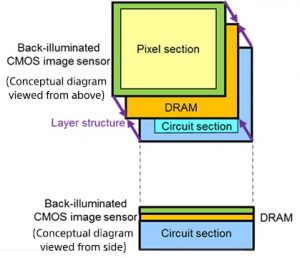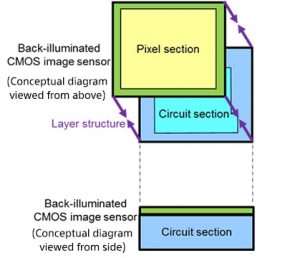1,000fps in Full HD
3-Layer Stacked CMOS Image Sensor with DRAM
Sony announced the development of a 3-layer stacked CMOS image sensor with DRAM for smartphones. The new image sensor consists of a DRAM layer added to the conventional 2-layer stacked CMOS image sensor with a layer of back-illuminated structure pixels and a chip affixed with mounted circuits for signal processing.

The 3-layer stacked CMOS is capable of reading one still image of 19.3 million pixels in only 1/120 of a second. Left: Conventional 2-layer stacked CMOS image sensor; right: 3-layer stacked CMOS image sensor with DRAM (Figure: Sony Europe)
The newly developed sensor with DRAM delivers fast data readout speeds, making it possible to capture still images of fast-moving subjects with minimal focal plane distortion as well as super slow motion movies at up to 1,000fps in full HD (1,920×1,080 pixels). Further key specifications are an effective pixel count of 5,520×3,840 Pixels (21,2MP). Frame rates of 30fps (still images), 60fps (4K movies) or 240fps (full HD movies) are possible. In order to realize the high-speed readout, the circuit used to convert the analogue video signal from pixels to a digital signal has been doubled from a 2-tier to a 4-tier construction in order to improve processing ability. Although there are speed limitations in the interface specifications for outputting signals from image sensors to other LSIs, this sensor uses DRAM to store signals read at high speed temporarily, enabling data to be output at an optimal speed for standard specifications. As a result, the product is capable of reading one still image of 19.3 million pixels in only 1/120 of a second. This makes it possible to record vibrant movies on a smartphone that seamlessly combine normal speed movies and super slow motion movies. To ensure that users don’t miss split-second moments in super slow motion movies, it is possible to adjust settings in a way that sudden subject movement is automatically detected and high-speed shooting begins. Because high-speed shooting data is stored on the DRAM and given out at a normal speed, a conventional ISP can be used. The new sensor also includes solutions for various technical problems inherent in the design, for instance reducing the noise generated between the circuits on each of the three layers.













